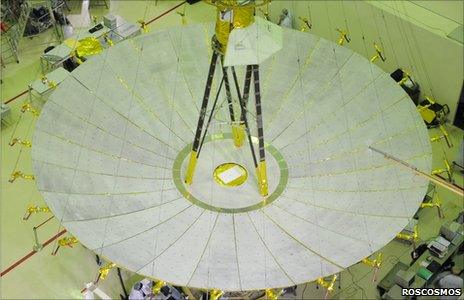Giant space scope RadioAstron reaches orbit
- Published

RadioAstron's antenna is 10m in diameter
RadioAstron, a Russian radio telescope intended to be the biggest radio telescope in space, has started touring the Earth for the first time.
Once operational, the 3.8 tonne "space eye" could help focus in on many remote places of the Universe.
The device will travel in an elliptical orbit that at its furthest reaches almost as far as the Moon.
Carried by a Zenith-3M rocket, it blasted off from Kazakhstan's Baikonur Cosmodrome on Monday.
The telescope is part of a Russian space observatory called Spectrum-R.
Despite RadioAstron's antenna being only 10m across - far smaller than the antennas of many other radio telescopes on Earth - its signals are meant to be combined with those on the ground, effectively making it the biggest radio telescope in space.
No rivals
Shortly after the observatory reached its designated orbit, it successfully opened its solar panels, said Viktor Khartov, head of Lavochkin R&D that built the device.
He said that it would take the craft eight days and seven hours to circle the Earth.
"On the fifth day [after the launch] the telescope's mirror will open, and in the three following months we will prepare the observatory for practical work," he added.
Although RadioAstron is expected to deliver more precise data than the US space veteran Hubble, the Russian Federal space agency Roscosmos said the apparatus was not meant to replace it.
"Hubble is an optical telescope and RadioAstron is radio," Aleksei Kuznetsov, Roscosmos' spokesperson, told BBC News. "I would say that the two will complement each other."
Once RadioAstron's 27 carbon fibre petals open up to form a dish, the telescope will start to collect data, then combine it with observations captured by radio telescopes on Earth.
This technique of combining images from a network of telescopes to form a single image is called interferometry.
The result is expected to have an incredibly high resolution - as if taken by a telescope with a dish as wide as the maximum distance between the antennas - from the Earth to the Moon.
One of the telescope's primary goals is to zoom in to the neighbouring galaxy M-87, some 59 million light years from Earth.

The telescope was delivered into orbit by a rocket that launched from Baikonur Cosmodrome
Scientists believe that there is a black hole there, and RadioAstron's mission is to confirm this hypothesis.
Researchers are also after some detailed data about pulsars, interstellar plasma and neutron stars in the Milky Way.
Soviet legacy
The Soviets first started building the telescope back in the 1980s, but the project was shelved when the USSR collapsed in 1991.
"In the 1990s, financial hurdles prevented us from completing the observatory, but in recent years Russia has come back to it," said Mr Kuznetsov.
"The launch of Spectrum-R is one of the main aspects of Roscosmos' space programme."
According to Roscosmos, the observatory is expected to remain in operation for at least five years.
Later in 2011, Russia also plans to go forward with its Phobos-Grunt mission, which involves sending a craft to Phobos, one of Mars' moons, to explore its surface.
- Published19 July 2011
- Published1 July 2011